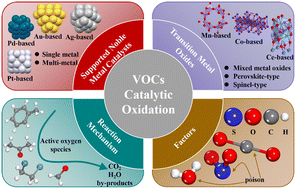Recent progress on catalysts for catalytic oxidation of volatile organic compounds: a review
Abstract
Volatile organic compounds (VOCs), one class of pollutants which not only cause a series of environmental issues but do extreme harm to human health, have attracted extensive attention. Therefore, it is urgent to treat VOCs to reduce their emissions and control terminal treatment. Catalytic oxidation is considered as a promising technology for VOC removal due to its low energy consumption, high safety coefficient, and no secondary pollutants. This review systematically summarizes the developments and progress made in the design and understanding of catalysts in recent years. It discusses in detail the oxidation mechanism of VOCs according to the categories of VOCs. It further highlights advances for VOC removal catalysts, mainly including supported noble metal catalysts (SNMCs) and transition metal oxides (TMOs) with economical and effective catalytic oxidation in recent years. It highlights the influence of reaction conditions and a series of factors on the catalytic performance for VOCs. It also addresses how water vapor, SO2, and CO2 affect the deactivation of catalysts and proposes corresponding regeneration approaches. The future directions for developing effective and stable catalysts for VOC oxidation at lower temperatures are provided as guide. This review will lay solid theoretical and experimental foundations for rational design and fabrication of novel catalysts toward VOC degradation in future.



 Please wait while we load your content...
Please wait while we load your content...